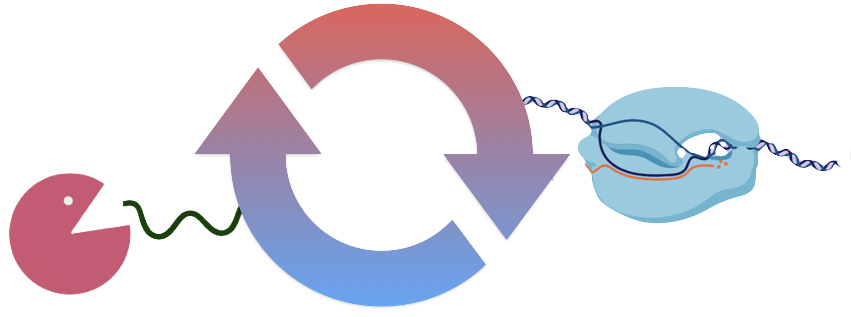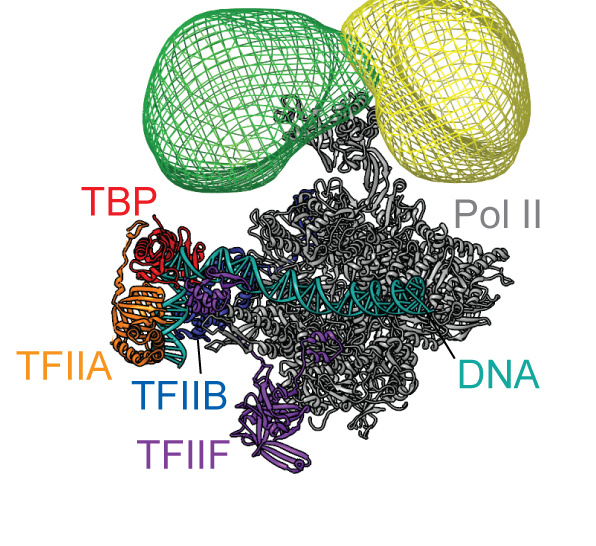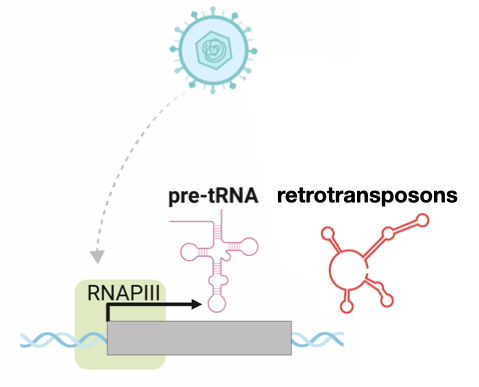Mechanisms & Consequences of Virus-Induced Messenger RNA Degradation

The ability to regulate RNA stability has the potential to impact gene expression on a global scale, but is also critical for fine-tuning cellular responses to specific stimuli. We showed that gammaherpesviruses such as Kaposi’s sarcoma-associated herpesvirus encode an endonuclease termed SOX that coordinates with mammalian messenger RNA (mRNA) decay machinery to promote widespread degradation of mRNAs. SOX uses a combination of RNA sequence and structure to achieve both targeting breadth and specificity.
How do cells sense and respond to these broad changes in RNA abundance? Our recent work has shown that virus-induced mRNA cleavage and degradation triggers diverse alterations in the gene expression cascade, including differential nuclear-cytoplasmic shuttling of RNA binding proteins and global dampening of RNA polymerase II occupancy on the mammalian genome. Current projects are centered on dissecting connections between the last and the first stage of the mRNA lifecycle, as well as deciphering the biology and targeting mechanisms of viral factors that dampen host gene expression. Beyond herpesviruses, we study how functionally related proteins from a variety of viruses (including coronaviruses and poxviruses) reshape the cellular RNA landscape.
Some of our publications on this topic:
Ella Hartenian and Britt Glaunsinger. Download
Hartenian E, Glaunsinger BA. Crit Rev Biochem Mol Biol. 2019 Aug;54(4):385-398.Download
Sarah Gilbertson, Joel Federspiel, Ella Hartenian, Ileana Cristea, Britt Glaunsinger. Download
Aaron Stephen Mendez, Carolin Vogt, Jens Bohne, Britt A Glaunsinger. Download
Abernathy E, Gilberson S, Alla R, and Glaunsinger B. Download
Novel Modes of Transcriptional Regulation During Late Stages of Infection

A universal feature of dsDNA viruses is that they all encode a class of genes whose expression is intimately linked to replication of the viral genome. These are termed ‘late genes’, and their transcription is robustly stimulated after the onset of DNA replication but otherwise restricted. Recent studies indicate that late gene transcriptional regulation in these viruses is unique, as it incorporates both molecular mimicry and selective recruitment of key host transcriptional machinery in a manner not previously observed in viral or host gene expression. In particular, one of the viral proteins required for late gene transcription directly binds both Pol II and promoter DNA, making this a unique viral transcriptional coordinator—and the first example of its kind in higher eukaryotes or eukaryotic viruses. We are currently working to understand how this hybrid virus-host preinitiation complex is assmembed and regulated. This viral model is anticipated to reveal new modes of transcriptional control, which may well have parallels in mammalian gene expression.
Some of our publications on this topic:
Angelica F Castañeda*, Allison L Didychuk*, Robert K Louder, Chloe O McCollum, Zoe H Davis, Eva Nogales and Britt Glaunsinger (*equal contribution) PLoS Pathogens, Sept 2020 Download
Divya Nandakumar and Britt Glaunsinger. Download
Davis ZH, Verschueren E, Jang GM, Kleffman K, Johnson JR, Park J, Von Dollen J, Maher MC, Johnson T, Newton W, Jäger S, Shales M, Horner J, Hernandez RD, Krogan NJ, Glaunsinger BA. Download
Viral Activation and Co-option of Noncoding RNA

Nearly half of the mammalian genome is composed of transposable elements, which are silent—at least most of the time. However, a subset of these elements that do not encode for any proteins, termed short interspersed nuclear repeats, or SINEs, can get activated in response to viral infection. The B2 subfamily of SINEs are evolutionarily related to transfer RNAs (tRNA), which are essential for decoding mRNA into protein during translation. We found that murine gammaherpesvirus infection causes dramatic upregulation of many B2 SINE noncoding RNAs and tRNA loci. These noncoding RNAs likely engage cellular RNA processing and sensing machinery, influencing the cellular response to infection. Current projects are aimed at understanding how gammaherpesvirus infection causes selective RNA polymerase III activation of a subset of tRNAs and B2 SINEs, as well as dissecting the functional consequences of these virally induced noncoding RNAs.
Some of our publications on this topic:
Tucker JT, Schaller AM, Willis I and Glaunsinger B. mBio, 2020 11:e02664-20Download
Aaron M. Schaller, Jessica Tucker, Ian Willis, Britt A. Glaunsinger. J. Virol. 2020 Jul 1;Download
Karijolich J, Yang Y, Glaunsinger B. Download
